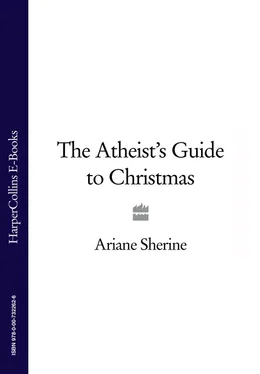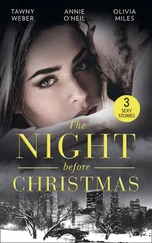Over time, things—as they tend to do—changed. I was never that big on anything in the Jewish religion, even when I was very young. By middle school I was for all practical purposes an atheist…and I suppose that has never changed since, come to think of it. But despite that, my attitude towards the holiday season evolved.
In secondary school, my best friend was Marc. His family was kinda sorta Jewish (the father) and some flavour of Christian (the mother), and they had long since decided to celebrate Christmas every year as a family event. Marc and I were pretty close, so I was over at their house a lot, including at Christmas time. When the holiday approached I would help them get their tree, set it up, string the beads or fake cranberries or whatever the heck they were—I remember one year we tried popcorn, but were less than successful getting it to stay on the fishing line—and then we’d decorate the tree.
On the night before Christmas, my non-Christian house would be business as usual—dinner, fool around, read, whatever. Even then I was the budding astronomer, so I might take out my telescope for some relaxing, but frigid, sky viewing. But eventually I’d go to bed, unhappy that every freaking TV and radio station (this was long before the web, kiddies) was either playing the dreaded jingles or was simply off the air.
Once I was up in the morning the long wait would begin. I knew Marc and his brother Dave would have been up early, opening presents, getting all kinds of awesome gifts. One year they both got Nikon cameras; we were heavily into photography then, with my bathroom at home being a makeshift darkroom complete with noxious chemicals that my mom was always giving me grief over. The Nikon camera Marc got was really nice, much better than my crappy Konica…but no, jealousy wasn’t an issue then. Of course not.
Finally, after a tortuous wait, Marc would call and invite me over, and I honestly had fun sharing in their celebration. His mom would make a Yule log cake, and we’d eat tons of chocolate and then go outside in the snow and have fun.
So for a while Christmas was really cool. Of course, in high school I was a band dork, and that meant every December concert I played Christmas music. So the barely restrained murderous impulse was still there, but mollified a bit.
In college, things died down somewhat because all the other students left to go home and be with their families for the holiday. It was great for me because I could stay behind and make good use of all the fallow computers. My software written to analyse and model astronomical data ran scads faster since the machines were otherwise idle. I always got a huge amount done during those weeks.
But it was lonely.
With one exception, for a few years Christmas was neither a joy nor a drag. The holiday was just something that happened, a few weeks of sales at the stores, barely tolerable jingles over half-shot speakers at the malls, and half-price chocolate bars the day after the holiday. The one exception that stands out was spent studying for my PhD qualifying exams. I was home with my parents but I hardly saw them; I was up every night until 2 or 3 a.m. studying and doing endless exercises in calculus, physics, and astronomy. That particular holiday is now blurry in my memory, difficult to distinguish from fiercely complicated equations, dozens of pages of algebraic computations and notes, and endlessly having to sharpen my pencils.
But this too did pass. As did I, as far as my exams went. But it wouldn’t be the last time I would associate Christmas and astronomy.
To me, when I was younger, winter months always meant crisp, clean air, the sharp pinpoints of stars in the sky undimmed by the East Coast’s summer haze. In December especially, while my friends were dreaming of gifts and fun, my thoughts would turn to the brilliant colours of the stars in Orion as the constellation stood solidly over my southern horizon. I read everything I could about astronomy, and also practised what I read: I would haul my 80-kilo telescope to the end of the driveway and, shivering in the sub-freezing temperatures, patiently aim it at various objects in the sky. Jupiter, Venus, the Orion Nebula…these all became my friends as I spotted and studied them.
It was around that time of my life when it dawned on me that people generally misunderstood astronomy. I myself was a victim of this; when I was of a certain age I believed in all manner of nonsense, including UFOs, the Bermuda Triangle and astral projection (well, I didn’t actually believe in that last one, as even then I was a budding skeptic and decided to do some experimental testing; I tried to project my mind using a book I found at the library, but, sadly, the girl I had a crush on showed no signs the next day that I had spent an hour trying to communicate with her from a higher plane).
The more I read about astronomy, the more instances I found of people misapplying it. Horoscopes were hugely popular, of course, as was the idea of aliens having visited humans, teaching us how to draw really long straight lines in the desert and paint confusing imagery on our stone walls.
And, of course, every year in December, the newspapers would have articles about the Christmas Star. You know the story: a star appears in the sky to guide the three wise men to the birthplace of Jesus. From the King James Version:
Now when Jesus was born in Bethlehem of Judaea in the days of Herod the king, behold, there came wise men from the east to Jerusalem,
Saying, Where is he that is born King of the Jews? for we have seen his star in the east, and are come to worship him.
A lot of folks in America like to interpret the Bible literally, so this passage is clear enough: an actual new Star appeared in the sky that guided the wise men to Jesus. Ignoring for a moment that if they lived to the east, and followed the Star to the east, they’d get further from Bethlehem rather than closer, and that while Matthew makes a big deal of the Star, Luke doesn’t even mention it—which already makes a literal interpretation of the Bible somewhat dicey—what we have here is an obvious astronomical tie-in with Christmas.
It’s a star, after all.
Even as a lad I could see the implications of this story, and certainly every Christmas special on TV has some variation of a brilliant star in the sky as a symbol for Christmas. Really, my getting involved once again with Christmas was unavoidable.
So I thought this legend over. Was the Star real? A lot of people thought so. That meant I had to look at the evidence.
It’s thought that the wise men were astrologers, so they would’ve had some familiarity with the sky; back then astronomy and astrology were pretty much the same thing, even if today they are as different as real medicine and homeopathy, or stage magicians and psychics, or…well, you get the point.
The point is, these guys would know the sky pretty well. If we take the Star at face value, then it must’ve been something amazing, because these three guys wouldn’t have dropped everything to make a long trek over some mundane star. The obvious conclusion is that it must have been very bright.
What astronomical objects are bright, can appear in the east, and disappear after some amount of time?
While there are lots of potential candidates, to an astronomer the answer is obvious: a supernova—a star that explodes at the end of its lifetime—is a perfect fit. So all we need to do for proof of this idea is to look for a 2,000-year-old supernova remnant, the expanding gas from such an explosion.
And lo, some do exist! But it turns out they wouldn’t have been in the east, or wouldn’t have been bright enough.
Certainly none fit the story well enough, and it’s doubtful any would’ve been enough to suddenly inspire a trio of men to get a hankering for a road trip in the desert.
Читать дальше












